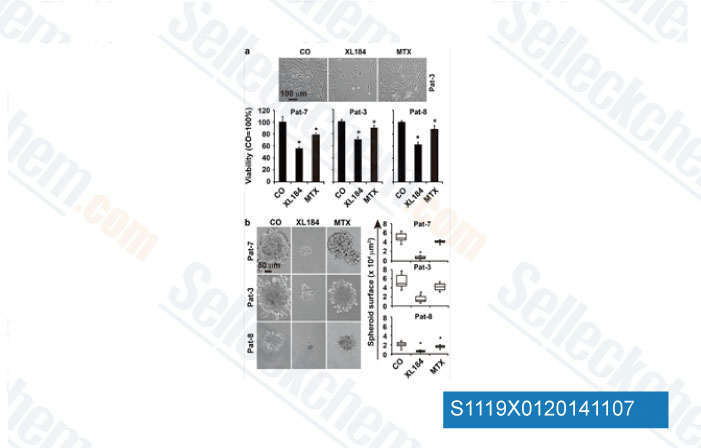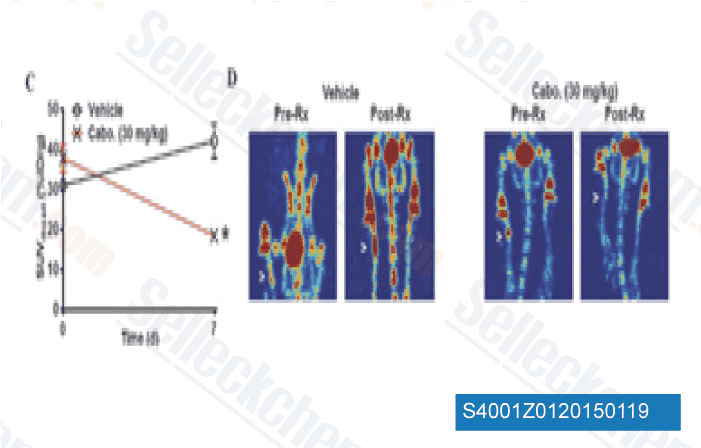|
How to Cite 1. For In-Text Citation (Materials & Methods): 2. For Key Resources Table: |
||
|
Toll Free: (877) 796-6397 -- USA and Canada only -- |
Fax: +1-832-582-8590 Orders: +1-832-582-8158 |
Tech Support: +1-832-582-8158 Ext:3 Please provide your Order Number in the email. We strive to reply to |
Technical Data
| Formula | C28H24FN3O5.C4H6O5 |
||||||
| Molecular Weight | 635.59 | CAS No. | 1140909-48-3 | ||||
| Solubility (25°C)* | In vitro | DMSO | 100 mg/mL (157.33 mM) | ||||
| Water | Insoluble | ||||||
| Ethanol | Insoluble | ||||||
| In vivo (Add solvents to the product individually and in order) |
|
||||||
|
* <1 mg/ml means slightly soluble or insoluble. * Please note that Selleck tests the solubility of all compounds in-house, and the actual solubility may differ slightly from published values. This is normal and is due to slight batch-to-batch variations. * Room temperature shipping (Stability testing shows this product can be shipped without any cooling measures.) |
|||||||
Preparing Stock Solutions
Biological Activity
| Description | Cabozantinib malate (XL184) is the malate of Cabozantinib, a potent VEGFR2 inhibitor with IC50 of 0.035 nM and also inhibits c-Met, Ret (c-Ret), Kit (c-Kit), Flt-1/3/4, Tie2, and AXL with IC50 of 1.3 nM, 4 nM, 4.6 nM, 12 nM/11.3 nM/6 nM, 14.3 nM and 7 nM in cell-free assays, respectively. This compound induces apoptosis. | |||||||||||
|---|---|---|---|---|---|---|---|---|---|---|---|---|
| Targets |
|
|||||||||||
| In vitro | Cabozantinib malate has weak inhibitory activity against RON and PDGFRβ with IC50 of 124 nM and 234 nM, respectivey, and has low activity against FGFR1 with IC50 of 5.294 μM. [1] This compound at low concentration (0.1-0.5 μM) is sufficient to induce marked inhibition of constitutive and inducible Met phosphorylation and its resultant downstream signaling in MPNST cells, and inhibit HGF-induced MPNST cell migration and invasion. It also induces marked inhibition of Met and VEGFR2 phosphorylation in cytokine-stimulated human umbilical vein endothelial cells (HUVECs). Although this chemical has no significant effect on MPNST cell growth at 0.1 μM, it at 5-10 μM significantly inhibits the MPNST cell growth. [2] | |||||||||||
| In vivo | Cabozantinib malate treatment at 30 mg/kg in RIP-Tag2 mice with spontaneous pancreatic islet tumors disrupts 83% of the tumor vasculature, reduces pericytes and empty basement membrane sleeves, causes widespread intratumoral hypoxia and extensive tumor cell apoptosis, and slows regrowth of the tumor vasculature after drug withdrawal, more significantly compared with XL999 that blocks VEGFR but not c-Met, leading to only 43% reduction in vascularity, suggesting that concurrent inhibition of VEGFR and other functionally relevant receptor tyrosine kinases (RTK) amplifies angiogenesis inhibition. This compound also decreases invasiveness of primary tumors and reduces metastasis. [1] This chemical at 30 mg/kg/day significantly abrogates human MPNST xenografts growth and metastasis in SCID mice. [2] Administration of this compound induces dose-dependent inhibition of tumor growth in breast, lung, and glioma tumor models, in association with decreased tumor and endothelial cell proliferation as well as increased apoptosis. A single oral dose of this chemical is sufficient to induce sustained tumor growth inhibition in MDA-MB-231 tumor-bearing mice and C6 tumor-bearing rats at 100 mg/kg and 10 mg/kg, respectively. [3] |
Protocol (from reference)
| Cell Assay: |
|
|---|---|
| Animal Study: |
|
References
|
Customer Product Validation

-
Data from [ Cancer Discov , 2014 , 4(7), 816-27 ]

-
Data from [ Cell Death Dis , 2014 , 5, e1471 ]

-
Data from [ Liver Int , 2014 , 10.1111/liv.12524 ]

-
Data from [ Mol Imaging , 2014 , 10.2310/7290.2014.00026 ]
Selleck's Cabozantinib malate Has Been Cited by 111 Publications
| Biofabrication of pheochromocytoma and paraganglioma tumor organoids and assessment of response to systemic therapy [ Sci Rep, 2025, 15(1):35889] | PubMed: 41087622 |
| Tyrosine kinase inhibitors affect sweet taste and dysregulate fate selection of specific taste cell subtypes via KIT inhibition [ bioRxiv, 2025, 2025.08.15.670608] | PubMed: 40894646 |
| Piezo1 regulates meningeal lymphatic vessel drainage and alleviates excessive CSF accumulation [ Nat Neurosci, 2024, 10.1038/s41593-024-01604-8] | PubMed: 38528202 |
| Patient-derived rhabdomyosarcoma cells recapitulate the genetic and transcriptomic landscapes of primary tumors [ iScience, 2024, 27(10):110862] | PubMed: 39319271 |
| A subset of VEGFR-TKIs activates AMPK in LKB1-mutant lung cancer [ Cancer Sci, 2023, 114(4):1651-1662] | PubMed: 36459496 |
| A subset of VEGFR-TKIs activates AMPK in LKB1-mutant lung cancer [ Cancer Sci, 2023, 114(4):1651-1662] | PubMed: 36459496 |
| Identification of therapeutic sensitivities in a spheroid drug combination screen of Neurofibromatosis Type I associated High Grade Gliomas [ PLoS One, 2023, 18(2):e0277306] | PubMed: 36730269 |
| Rapid Profiling of Tumor-Immune Interaction Using Acoustically Assembled Patient-Derived Cell Clusters [ Adv Sci (Weinh), 2022, e2201478] | PubMed: 35611994 |
| CIC-mediated modulation of MAPK signaling opposes receptor tyrosine kinase inhibitor response in kinase-addicted sarcoma [ Cancer Res, 2022, canres.1397.2021] | PubMed: 35074756 |
| Targeting PEA3 transcription factors to mitigate small cell lung cancer progression [ Oncogene, 2022, 10.1038/s41388-022-02558-6] | PubMed: 36509998 |
RETURN POLICY
Selleck Chemical’s Unconditional Return Policy ensures a smooth online shopping experience for our customers. If you are in any way unsatisfied with your purchase, you may return any item(s) within 7 days of receiving it. In the event of product quality issues, either protocol related or product related problems, you may return any item(s) within 365 days from the original purchase date. Please follow the instructions below when returning products.
SHIPPING AND STORAGE
Selleck products are transported at room temperature. If you receive the product at room temperature, please rest assured, the Selleck Quality Inspection Department has conducted experiments to verify that the normal temperature placement of one month will not affect the biological activity of powder products. After collecting, please store the product according to the requirements described in the datasheet. Most Selleck products are stable under the recommended conditions.
NOT FOR HUMAN, VETERINARY DIAGNOSTIC OR THERAPEUTIC USE.
